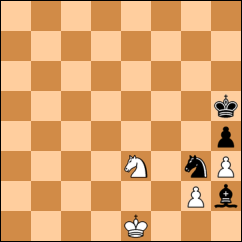Draw
Section A
Poul Rewitz (Denmark)
wKe1,Ne3,Pg2,h3/bKh5,Ng3,Bh2,Ph4
1.Nf1!
1.Kf2? is not a fortress, e.g.: 1…Ne4+ 2.Ke2 Bg3 3.Nc2 Ng5 4.Nd4 Kg6 5.Ke3 Kf6 6.Nf3 Ne6 7.Ke4 Kg6 8.Ne5+ Kg5 9.Nc4 Nc5+ 10.Kd4 Bf2+ 11.Ke5 Nd3+ 12.Ke4 Ne1 13.Nd2 Bg3 14.Nf3+ Kh5 15.Nd4 Nxg2–+
1.Ng4? is not a fortress, e.g.: 1…Bg1 2.Ne5 Bd4 3.Nc6 Bb6 4.Ne5 Bc7 5.Nf3 Bd8 6.Kf2 Kg6 7.Nd2 Bb6+ 8.Kf3 Kf5 9.Nc4 Bc5 10.Nd2 Ba7 11.Nb3 Ne4 12.Nc1 Bc5 13.Ke2 Kf4 14.Kd3 Ba7 15.Ne2+ Kf5 16.Kc2 Bf2 17.Nc1 Ng3 18.Kd1 Bb6 19.Nd3 Bd4 20.Ne1 Ke4 21.Nf3 Bf6 22.Ng1 Kf4 23.Kc2 Bd4 24.Nf3 Nf5 25.Kd2 Bb6 26.Kd3 Ba7 27.Kc3 Kg3 28.Kd3 Kxg2–+
1…Nxf1
1…Bg1 2.Nxg3+ hxg3= Black can win the h-pawn, but then it’s a fortress, with stalemates ideas on f1 and h1.
2.g4+! hxg3
2…Kg5 3.Kxf1= Black can win the h- and g-pawn, but then it’s a basic fortress, because of the wrong colored Bishop.
3.Kxf1 Kh4 4.Kg2= The third fortress. Black can win the h-pawn, but it is still a draw. Three standard fortresses against a Bishop in one study.

